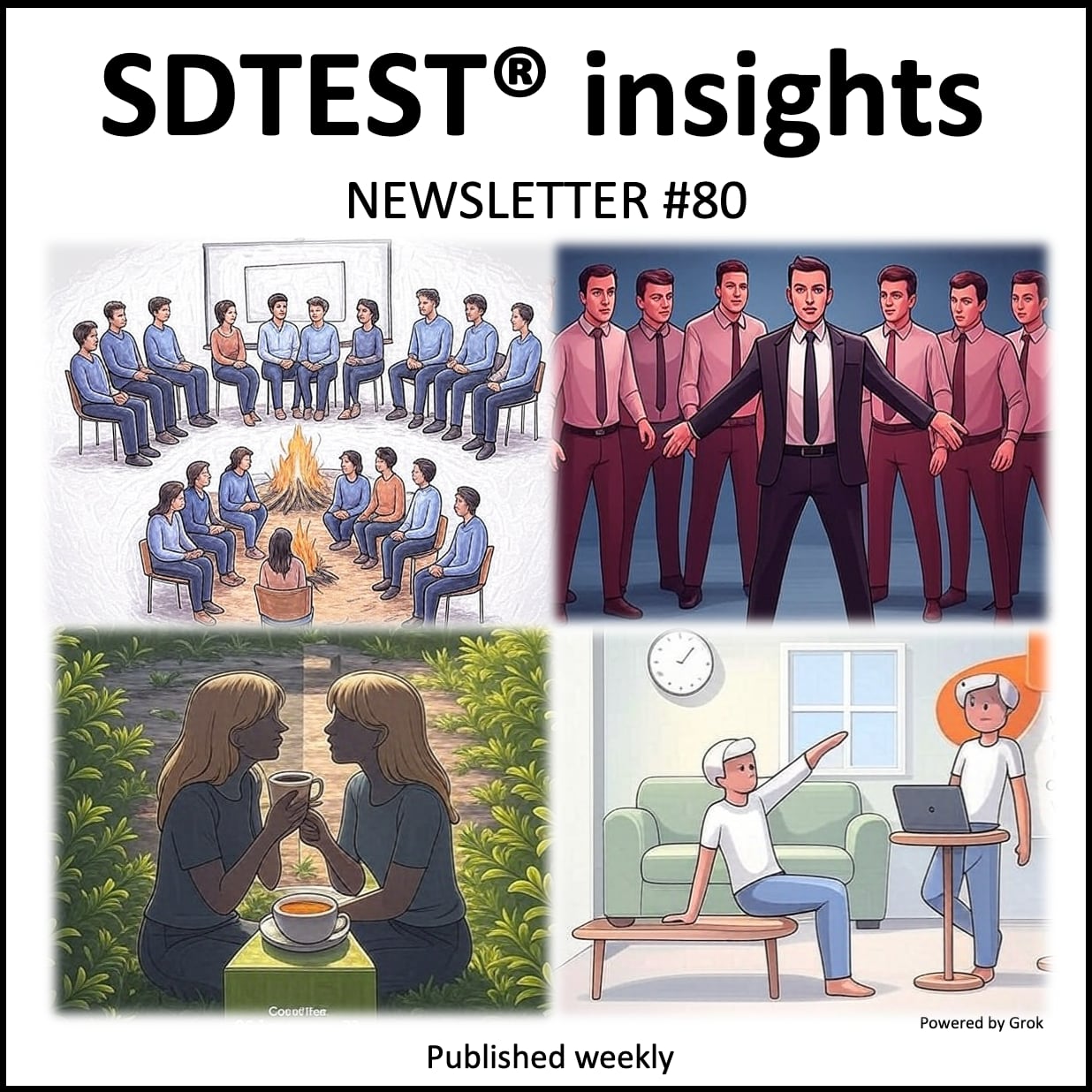SDTEST® has 38 different VUCA polls that calculate the 13,643 correlation values between stages of development according to the theory of Spiral Dynamics and answer options of these 38 polls.
We invite curiosity about the systemic mechanisms behind this correlation. There may be hidden variables that provide alternative explanations.
In our analysis of the poll "Meritocracy," we found an intriguing positive linear correlation that warrants closer examination:
0.0117 (Pearson) between the statement 'Yes, the organization provides opportunities for training and development to help employees acquire the necessary skills and knowledge to advance their careers' and the Purple stage.
The critical value of the correlation coefficient for a non-normal distribution, by Spearman, is r = 0.0063. Nevertheless, this positive linear correlation of 0.0117 meets the reliability criteria but does not necessarily imply causation.
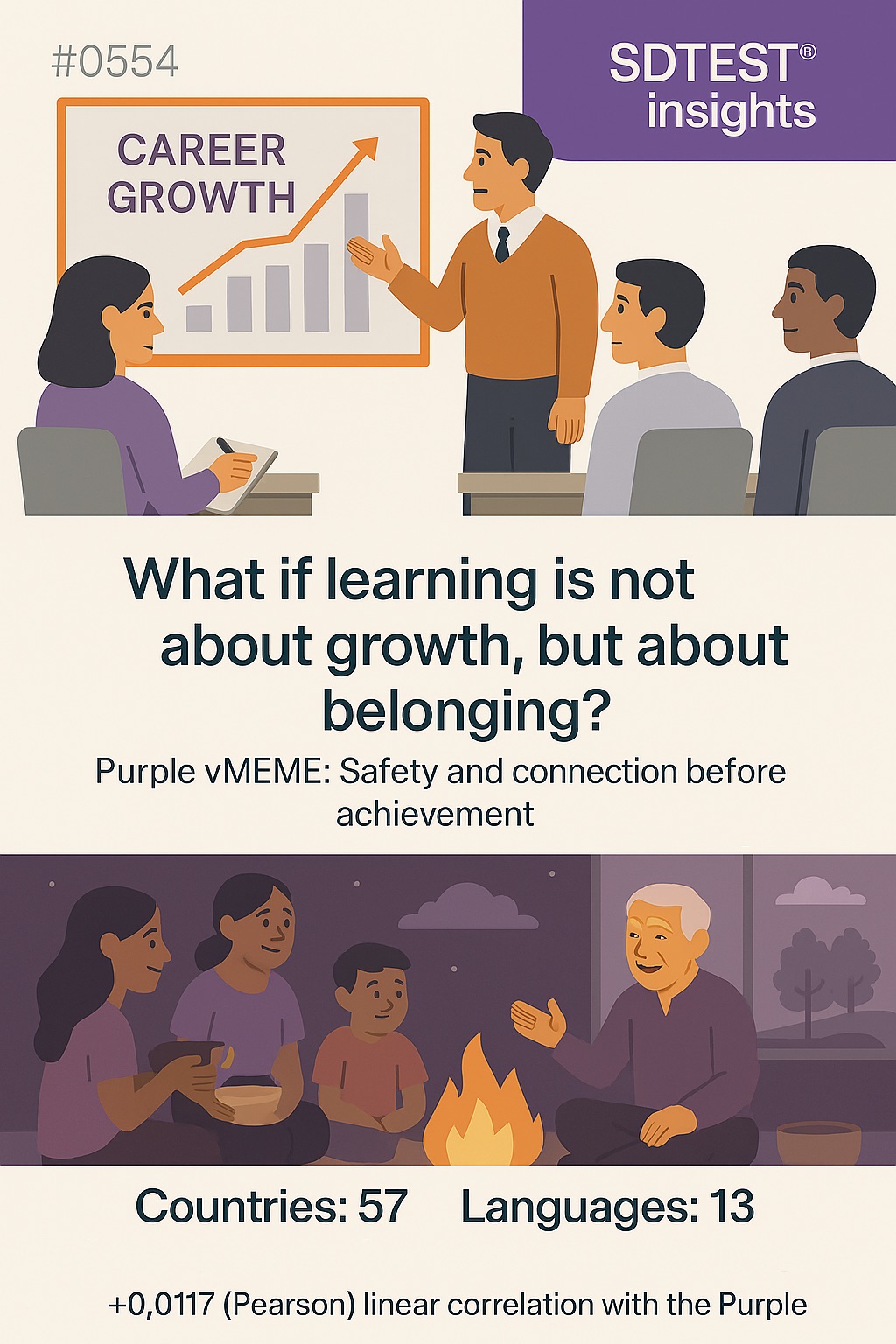
This positive correlation of 0.0117 between organizations providing training and development opportunities and the Purple stage offers profound insights when viewed through the lens of the Purple value system:
Organizational Perspective:
Organizations operating within the Purple mindset might interpret this correlation as:
- Validation of their sacred responsibility to nurture and guide their tribal members through traditional knowledge transmission and spiritual development rituals
- Confirmation that their role as spiritual stewards requires them to shepherd employees through ancestral wisdom and ceremonial learning experiences that honor the community's heritage
- Evidence supporting their belief that organizational growth comes through collective spiritual development and adherence to traditional pathways established by their founding ancestors
These organizations might respond by:
- Implementing apprenticeship programs that mirror traditional master-disciple relationships, where senior tribal members pass down sacred knowledge through ritual and ceremony
- Creating development pathways that follow ancestral patterns and spiritual traditions, ensuring advancement serves the community's spiritual mission
- Promoting leaders who embody the wisdom of elders and can guide others through traditional rites of passage that strengthen tribal bonds and spiritual connection
Team Perspective:
Teams operating from a Purple mindset might approach this correlation by:
- Viewing it as an affirmation of their collective responsibility to nurture each member's spiritual growth and connection to the group's sacred purpose
- Interpreting it as support for their belief that team development should follow traditional patterns that strengthen communal bonds and ancestral wisdom
- Seeing it as validation for their commitment to ensuring every team member receives the spiritual guidance and ceremonial preparation necessary for their role in the tribal community
These teams might respond by:
- Establishing mentorship circles that mirror traditional tribal learning structures, where experienced members guide newcomers through sacred knowledge and customs
- Encouraging team members to participate in ritual learning experiences that deepen their connection to the group's spiritual mission and ancestral traditions
- Celebrating instances where team members demonstrate growth in wisdom, spiritual understanding, and commitment to the community's sacred values
Individual Perspective:
Individuals aligned with the Purple value system might interpret this correlation as:
- Personal validation of their deep need for spiritual guidance and traditional wisdom that connects them to their ancestral heritage and community purpose
- Evidence supporting their belief that true advancement comes through spiritual development and deeper integration into the tribal community's sacred traditions
- Confirmation that their desire for learning reflects their commitment to serving the community's spiritual mission and honoring the wisdom of their ancestors
These individuals might respond by:
- Actively seeking mentorship and guidance from spiritual elders who can share ancestral wisdom and traditional knowledge
- Viewing their development opportunities as sacred rituals that deepen their connection to the community and spiritual purpose
- Using their learning experiences to strengthen their role as guardians of traditional knowledge and servants of the community's spiritual mission
This correlation, viewed through the Purple lens, suggests that those operating at the Purple level may see organizational development as a sacred responsibility and spiritual calling. It implies that the Purple value system's emphasis on community, tradition, and spiritual guidance naturally aligns with development opportunities that serve the collective good and honor ancestral wisdom.
The reasons why organizations might provide training and development opportunities in the Purple stage could include:
- Sacred Stewardship: Development is seen as a spiritual responsibility to nurture the community's members according to ancestral traditions and divine guidance
- Collective Wisdom: Training serves to preserve and transmit traditional knowledge that strengthens the entire tribal community's spiritual foundation
- Ritual Integration: Development opportunities function as modern rites of passage that deepen individuals' connection to the group's sacred mission
- Ancestral Guidance: Training follows traditional patterns established by spiritual leaders and ancestors, ensuring continuity of sacred knowledge
- Community Strengthening: Development serves to create stronger bonds among tribal members and ensure the community's spiritual mission continues across generations
This correlation prompts us to consider how different value systems understand the purpose and meaning of professional development. It raises questions about the potential for training programs to serve deeper spiritual and communal purposes beyond individual advancement.
Ultimately, this correlation highlights the Purple value system's integration of spiritual purpose with practical development. In Purple-dominant environments, organizational training might be seen not as mere skill-building but as sacred stewardship that honors ancestral wisdom, strengthens community bonds, and ensures the continuation of spiritual traditions that serve the collective good of the tribal community.
In our analysis of the poll "What makes a boss a great leader?" we found an intriguing negative linear correlation that warrants closer examination:
-0.0453 (Pearson) between the Empowering their people and the Red stage.
The critical value of the correlation coefficient for a non-normal distribution, by Spearman, is r = 0.0016. Nevertheless, this negative linear correlation of -0.0453 meets the reliability criteria but does not necessarily imply causation.
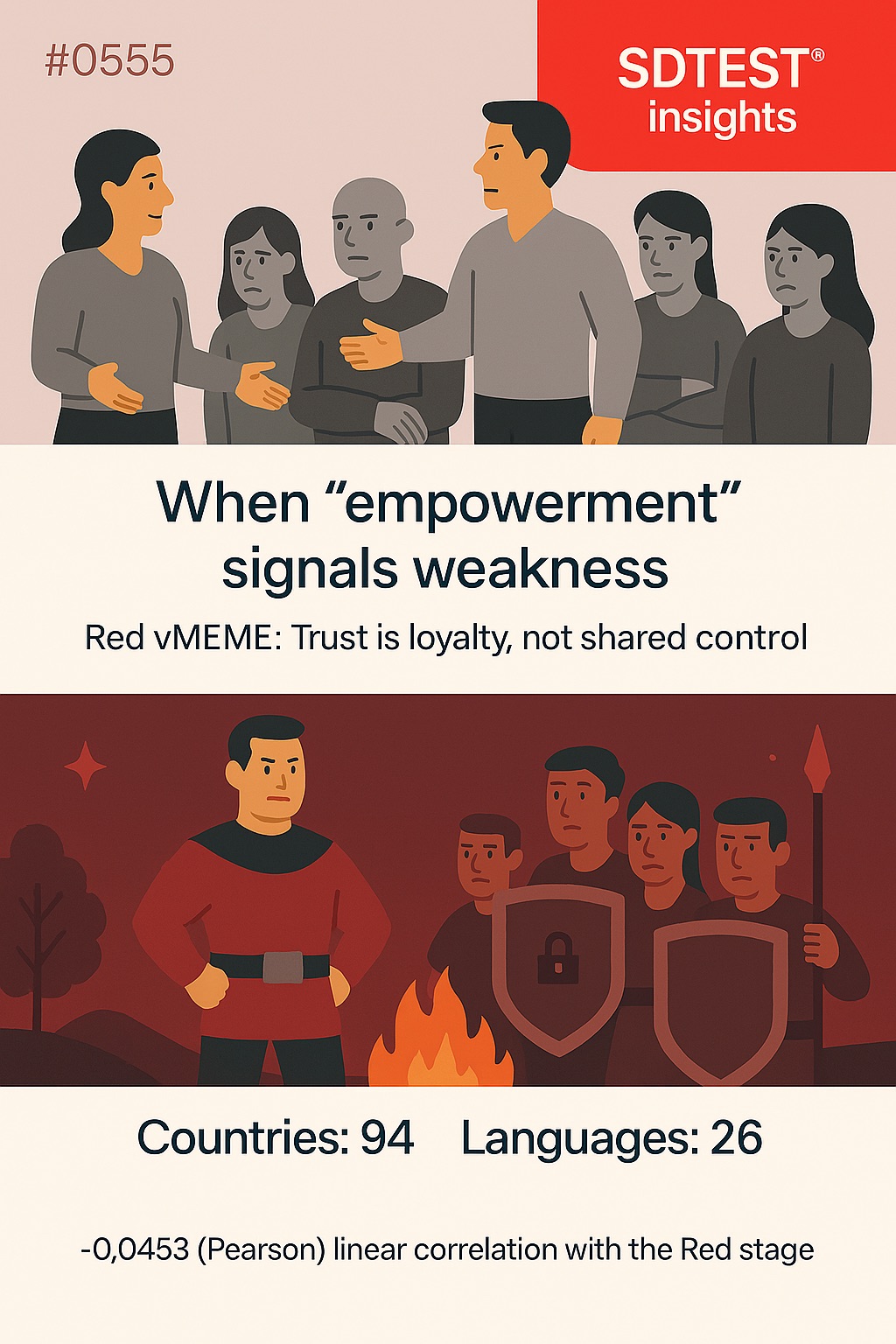
This negative correlation of -0.0453 between empowering their people and the Red stage offers compelling insights when viewed through the lens of the Red value system:
Organizational Perspective:
Organizations operating within the Red mindset might interpret this correlation as:
- Validation of their belief that true leadership requires direct control and personal dominance rather than delegating power to potentially weak or unreliable subordinates
- Confirmation that their command-and-control structure ensures immediate results and prevents the chaos that comes from empowering people who lack the strength to handle responsibility
- Evidence supporting their conviction that great leaders must personally drive outcomes through force of will and dominant presence rather than relying on others' capabilities
These organizations might respond by:
- Implementing centralized decision-making structures where powerful leaders maintain direct control over all critical outcomes and resources
- Rewarding leaders who demonstrate personal dominance and achieve results through their own force rather than through others' empowerment
- Promoting management styles that emphasize personal authority, immediate command, and the ability to compel action through strength and intimidation
Team Perspective:
Teams operating from a Red mindset might approach this correlation by:
- Viewing it as affirmation that effective leadership requires a strong alpha who can impose their will and drive results through personal power and dominance
- Interpreting it as support for their belief that team success depends on having a powerful leader who takes charge rather than distributing authority among weaker members
- Seeing it as validation for their preference for clear hierarchies where the strongest individual leads through force and personal example rather than empowerment strategies
These teams might respond by:
- Establishing clear power structures where the most dominant individual takes control and others follow their direct commands
- Encouraging team members to compete for the leader's favor rather than developing independent capabilities and decision-making authority
- Celebrating instances where leaders achieve results through personal force, intimidation, and direct action rather than through empowering others
Individual Perspective:
Individuals aligned with the Red value system might interpret this correlation as:
- Personal validation of their belief that true leadership means demonstrating superior strength and taking direct control rather than sharing power with potentially inferior subordinates
- Evidence supporting their conviction that empowering others shows weakness and undermines their ability to achieve immediate results through personal dominance
- Confirmation that their leadership style should focus on imposing their will and achieving personal victory rather than developing others' capabilities
These individuals might respond by:
- Actively maintaining tight control over all decisions and outcomes to demonstrate their personal power and superiority
- Viewing empowerment initiatives as threats to their authority and evidence of weak leadership that compromises results
- Using their position to showcase their individual strength and ability to achieve results through personal force rather than through others
This correlation, viewed through the Red lens, suggests that those operating at the Red level may see empowerment as incompatible with effective leadership. It implies that the Red value system's emphasis on personal power, dominance, and immediate results creates skepticism toward leadership approaches that distribute authority and rely on the development of others.
The reasons why empowering their people might not make a boss a great leader in the Red stage could include:
- Power Dilution: Empowering others weakens the leader's personal authority and reduces their ability to impose immediate solutions through force
- Weakness Demonstration: Sharing power signals that the leader lacks the strength and capability to handle challenges personally
- Control Loss: Empowerment creates unpredictability and removes the leader's ability to ensure immediate, direct results through personal dominance
- Competitive Disadvantage: Developing others' capabilities creates potential rivals who might challenge the leader's position and authority
- Immediate Gratification: Empowerment requires long-term investment when Red leaders prefer instant results achieved through personal action and force
This correlation prompts us to consider how different value systems influence the definition of effective leadership and organizational success. It raises questions about the potential benefits and limitations of dominance-based leadership in contexts requiring rapid response and clear authority.
Ultimately, this correlation highlights the Red value system's emphasis on personal power and direct control as primary leadership qualities. In Red-dominant environments, empowering people might be seen not as enlightened leadership but as dangerous weakness that compromises the leader's ability to achieve immediate results through personal strength, dominance, and force of will.
In our analysis of the poll "Why People Resist Change" (by Siobhán McHale [1]), we found an intriguing negative linear correlation that warrants closer examination:
-0.4219 (Pearson) between the Fear of failure and the Blue stage (Germany, 3 languages).
The critical value of the correlation coefficient for a normal distribution, by William Sealy Gosset (Student), is r = 0.3881. Nevertheless, this negative linear correlation of -0.4219 meets the reliability criteria but does not necessarily imply causation.
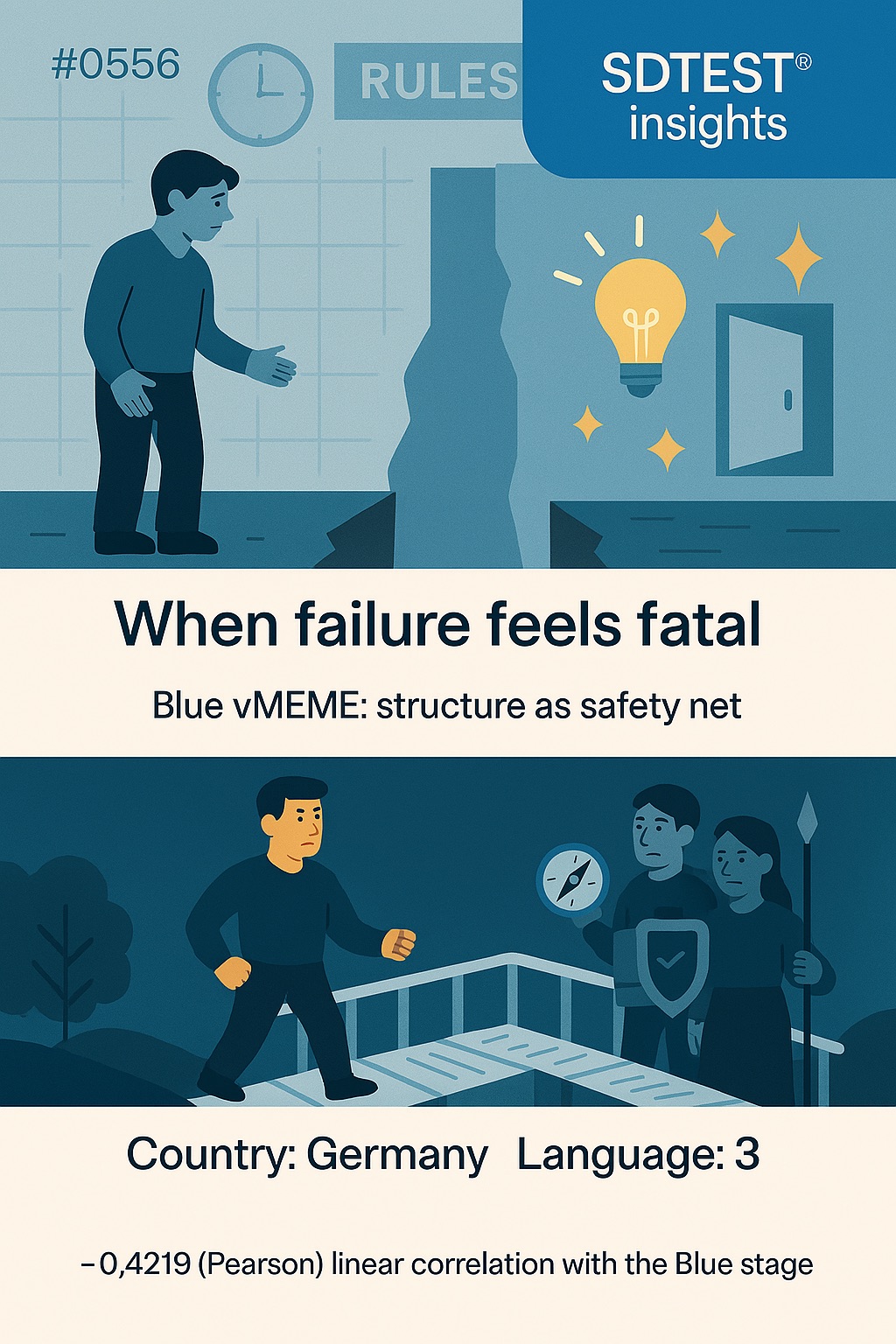
This negative correlation of -0.4219 between Fear of Failure and the Blue stage in modern Germany offers fascinating insights when viewed through the lens of the Blue value system:
Organizational Perspective:
Organizations operating within the Blue mindset in modern Germany might interpret this correlation as:
- Validation of their structured, rule-based approach to managing change and mitigating risks through established protocols.
- Confirmation that their hierarchical decision-making processes and adherence to proven methodologies reduce individual anxiety about failure.
- Evidence supporting their belief that proper procedures, training, and institutional frameworks protect employees from the chaos of unguided change.
These organizations might respond by:
- Strengthening their change management protocols and creating even more detailed procedural guidelines.
- Implementing systematic training programs that follow established best practices from authoritative sources.
- Promoting leaders who demonstrate unwavering commitment to organizational rules and proven methodologies.
Team Perspective:
Teams operating from a Blue mindset in Germany might approach this correlation by:
- Viewing it as an affirmation of their collective adherence to established team protocols and structured approaches to challenges.
- Interpreting it as support for their belief that following proper procedures and respecting team hierarchy protects against individual failures.
- Seeing it as validation for prioritizing group conformity and adherence to proven methods over individual risk-taking.
These teams might respond by:
- Reinforcing team standards and ensuring all members follow established protocols during change initiatives.
- Encouraging team members to trust in collective wisdom and institutional knowledge rather than individual judgment.
- Celebrating instances where following proper procedures led to successful outcomes, reinforcing the value of disciplined approaches.
Individual Perspective:
Individuals aligned with the Blue value system in modern Germany might interpret this correlation as:
- Personal validation of their disciplined approach to duty and their trust in established institutional frameworks.
- Evidence supporting their belief that following proper moral codes and professional standards provides security against failure.
- Confirmation of the value they place on conformity to group norms and respect for traditional German values of thoroughness and reliability.
These individuals might respond by:
- Actively seeking guidance from established authorities and following prescribed procedures during times of change.
- Viewing their adherence to rules and traditions as a source of strength and protection against uncertainty.
- Using their commitment to proper conduct and institutional loyalty as a foundation for navigating change confidently.
This correlation, viewed through the Blue lens, suggests that those operating at the Blue level in modern Germany may be less likely to fear failure when facing change. It implies that the Blue value system's emphasis on order, duty, and institutional trust aligns with a more secure approach to navigating transitions.
The reasons why Fear of Failure might not be prevalent in the Blue stage in modern Germany could include:
- Institutional Trust: Strong faith in German institutions and established systems provides security during change processes.
- Procedural Clarity: Well-defined rules and procedures offer clear pathways through change, reducing uncertainty about outcomes.
- Collective Responsibility: Group-oriented culture distributes responsibility, reducing individual anxiety about personal failure.
- Traditional Resilience: German cultural values of thoroughness, discipline, and methodical approaches build confidence in managing change.
- Hierarchical Support: Clear authority structures provide guidance and accountability frameworks that reduce individual fear of making wrong decisions.
This correlation prompts us to consider how different value systems influence responses to organizational and social change. It raises questions about the potential benefits and limitations of a Blue approach to change management, particularly in contexts where innovation and rapid adaptation are crucial.
Ultimately, this correlation highlights the complex interplay between cultural values, institutional frameworks, and individual psychology. In Blue-dominant environments like modern Germany, change might be approached not with fear but with disciplined confidence in proven systems and collective wisdom.
-0.1796 (Pearson) between the Flexible schedule of work and the Orange stage.
The critical value of the correlation coefficient for a normal distribution, by William Sealy Gosset (Student), is r = 0.1709. Nevertheless, this negative linear correlation of -0.1796 meets the reliability criteria but does not necessarily imply causation.
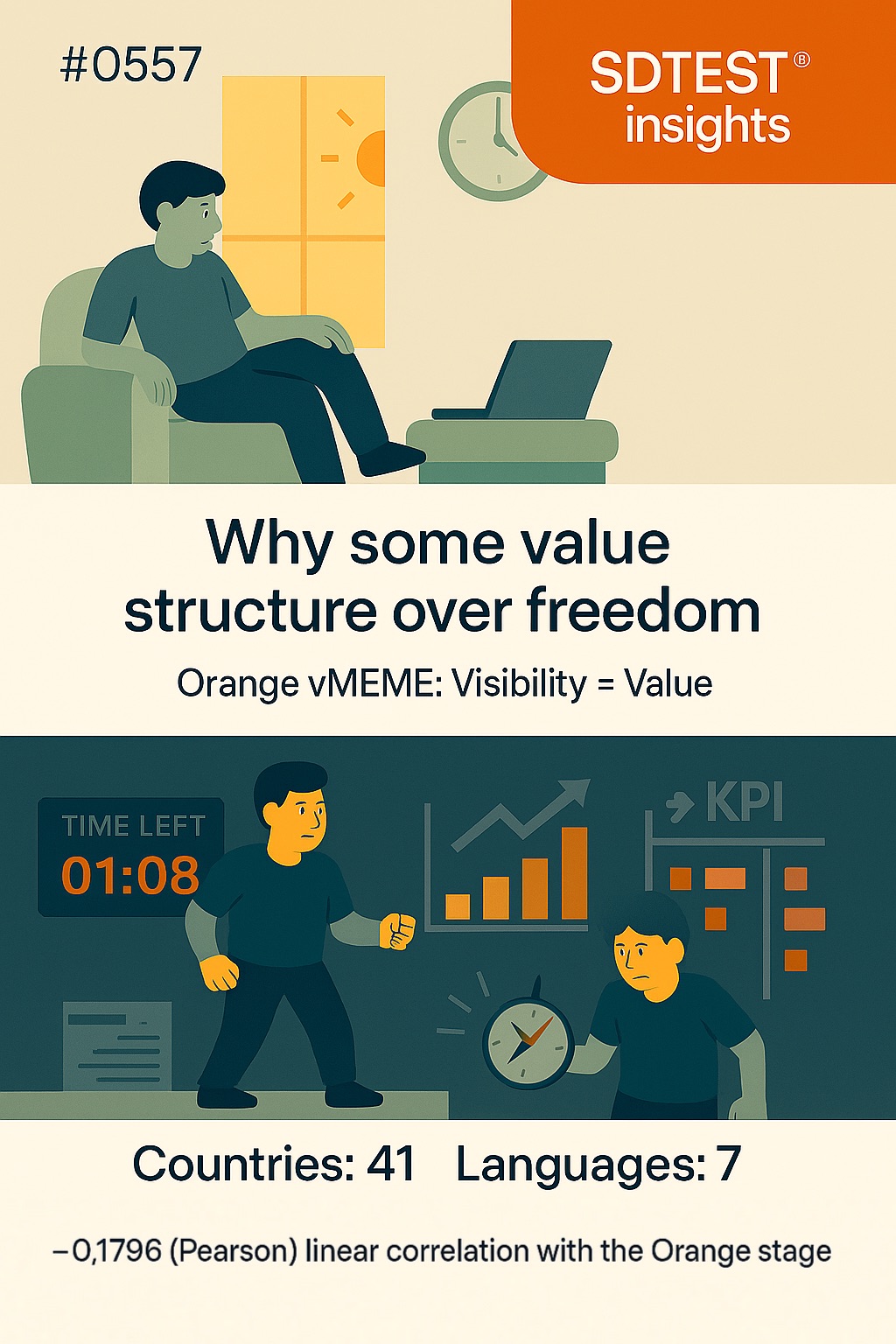
This negative correlation of -0.1796 between Flexible Schedule of Work and the Orange stage offers compelling insights when viewed through the lens of the Orange value system:
Organizational Perspective:
Organizations operating within the Orange mindset might interpret this correlation as:
- Validation of their results-driven approach, where performance metrics and deliverables matter more than employee autonomy over daily work hours.
- Confirmation that their competitive, goal-oriented culture attracts IT specialists who prioritize career advancement and compensation over personal schedule control.
- Evidence supporting their belief that structured work frameworks (for instance, 9:00-18:00 or timezone-aligned shifts) drive superior productivity and measurable outcomes.
These organizations might respond by:
- Implementing rigid time frameworks that maximize operational efficiency and client coverage without concern for employee schedule preferences.
- Creating advancement opportunities and performance bonuses that compensate for inflexible schedules while attracting ambitious IT professionals.
- Promoting leaders who can deliver exceptional results within fixed operational parameters, regardless of personal time preferences.
Team Perspective:
Teams operating from an Orange mindset might approach this correlation by:
- Viewing it as an affirmation of their project-focused approach, where synchronized availability and real-time collaboration outweigh individual schedule autonomy.
- Interpreting it as support for their belief that complex technical challenges require coordinated effort during predetermined hours, even if inconvenient for some members.
- Seeing it as validation for prioritizing collective technical excellence and project deadlines over individual time management preferences.
These teams might respond by:
- Accepting rigid schedule frameworks as necessary operational constraints that enable superior project execution and client service.
- Encouraging team members to adapt to fixed time zones or business hours as a demonstration of professional commitment and teamwork.
- Celebrating instances where adherence to inflexible schedules led to successful project deliveries and client satisfaction.
Individual Perspective:
Individuals aligned with the Orange value system might interpret this correlation as:
- Personal validation of their pragmatic, goal-oriented approach to career advancement over lifestyle preferences.
- Evidence supporting their belief that accepting rigid schedule constraints is a rational trade-off for superior compensation and growth opportunities.
- Confirmation of the value they place on measurable career progress and competitive positioning over personal time autonomy.
These individuals might respond by:
- Actively accepting job offers with fixed schedules (for instance, 9:00-18:00 or timezone requirements) when they provide optimal career advancement potential.
- Viewing their willingness to work within rigid time frameworks as a competitive advantage and demonstration of professional dedication.
- Using their adaptability to inflexible schedules as a means to access higher-level positions and more challenging technical assignments.
This correlation, viewed through the Orange lens, suggests that those operating at the Orange level may be less likely to prioritize schedule flexibility when choosing a job offer. It implies that the Orange value system's emphasis on achievement, rational decision-making, and competitive advantage aligns with accepting rigid work frameworks when they serve strategic career goals.
The reasons why a Flexible Schedule of Work might not be essential for IT specialists in the Orange stage could include:
- Strategic Career Calculation: Rigid schedules are accepted as necessary trade-offs for accessing premium career opportunities and compensation packages.
- Competitive Market Reality: Understanding that top-tier positions often require adherence to specific operational frameworks, regardless of personal preferences.
- Performance Optimization: Recognizing that structured time frameworks can actually enhance productivity metrics and measurable outcomes.
- Professional Adaptability: Viewing schedule flexibility as less important than demonstrating the capability to excel within any operational constraints.
- Goal-Oriented Pragmatism: Prioritizing tangible career advancement over personal convenience when making rational job selection decisions.
This correlation prompts us to consider how different value systems influence professional priorities and career decision-making. It raises questions about the potential benefits and limitations of an Orange approach to work-life integration, particularly in contexts where career advancement and financial optimization are paramount.
Ultimately, this correlation underscores the intricate interplay between value systems, professional aspirations, and market realities. For Orange-dominant IT specialists, career advancement and competitive positioning require strategic acceptance of rigid schedule frameworks, demonstrating rational prioritization of measurable professional gains over personal time autonomy.
In our analysis of the poll "Psychological Well-being" (by Carol D. Ryff), we found an intriguing positive linear correlation that warrants closer examination:
0.0664 (Pearson) between the Positive relations with others. I know that I can trust my friends, and they know they can trust me / Strongly agree and the Green stage.
The critical value of the correlation coefficient for a normal distribution, by William Sealy Gosset (Student), is r = 0.0473. Nevertheless, this positive linear correlation of 0.0664 meets the reliability criteria but does not necessarily imply causation.

This positive correlation of 0.0664 between "I know that I can trust my friends, and they know they can trust me / Strongly agree" and the Green stage offers profound insights when viewed through the lens of the Green value system:
Organizational Perspective:
Organizations operating within the Green mindset might interpret this correlation as:
- Validation of their collaborative, community-centered approach that prioritizes authentic relationships and mutual support over hierarchical power structures.
- Confirmation that their emphasis on psychological safety, inclusive decision-making, and holistic employee wellbeing creates environments where trust naturally flourishes.
- Evidence supporting their belief that sustainable organizational success depends on genuine human connections and collective care for all stakeholders.
These organizations might respond by:
- Implementing trust-building initiatives that emphasize authentic communication, vulnerability, and mutual support among all organizational members.
- Creating collaborative spaces and processes that prioritize collective wellbeing and shared responsibility over individual competition.
- Promoting leaders who demonstrate genuine care for community building and can foster deep, meaningful relationships across all organizational levels.
Team Perspective:
Teams operating from a Green mindset might approach this correlation by:
- Viewing it as an affirmation of their consensus-driven, relationship-centered approach, where every team member's voice and well-being matter equally.
- Interpreting it as support for their belief that authentic trust emerges from shared values, mutual respect, and collective commitment to each other's growth.
- Seeing it as validation for prioritizing emotional intelligence, empathy, and genuine care for team members over task-focused efficiency.
These teams might respond by:
- Establishing regular check-ins and sharing circles that strengthen interpersonal bonds and create space for authentic vulnerability.
- Encouraging team members to support each other's holistic development and celebrate collective achievements over individual recognition.
- Creating rituals and practices that honor the interconnectedness of team members and reinforce their commitment to mutual trust and support.
Individual Perspective:
Individuals aligned with the Green value system might interpret this correlation as:
- Personal validation of their authentic, relationship-centered approach to building meaningful connections based on shared values and mutual care.
- Evidence supporting their belief that genuine trust emerges from emotional openness, empathy, and commitment to others' well-being.
- Confirmation of the value they place on creating inclusive, supportive relationships that honor the whole person rather than just functional interactions.
These individuals might respond by:
- Actively cultivating deeper, more authentic friendships through vulnerable sharing, active listening, and genuine concern for others' holistic well-being.
- Viewing their capacity for trust as a reflection of their commitment to community values and interconnectedness with others.
- Using their relationships as opportunities to practice compassion, mutual support, and collective growth toward shared ideals.
This correlation, viewed through the Green lens, suggests that individuals operating at the Green level may be more likely to experience and express deep mutual trust in their friendships. It implies that the Green value system's emphasis on community, authenticity, and holistic well-being aligns with a more open and trusting approach to human relationships.
The reasons why people strongly agree that they can trust their friends in the Green stage could include:
- Authentic Vulnerability: Green values encourage genuine openness and emotional honesty, creating foundations for deep trust.
- Shared Values Alignment: Friendships form around common commitments to community wellbeing, sustainability, and mutual care.
- Holistic Relationship Approach: Trust extends beyond functional interactions to encompass care for each other's complete well-being and growth.
- Consensus-Building Mindset: Green thinking emphasizes collaborative decision-making and mutual support, reinforcing trustworthy behaviors.
- Interconnectedness Awareness: Understanding that individual well-being is connected to collective health motivates trustworthy, supportive actions.
This correlation prompts us to consider how different value systems influence the depth and quality of human relationships. It raises questions about the potential benefits and challenges of a Green approach to friendship and trust, particularly in contexts where individual boundaries and diverse perspectives need to be honored.
Ultimately, this correlation highlights the complex interplay between value systems, relationship dynamics, and psychological well-being. In Green-dominant environments, trust might be viewed not as a transactional commodity but as a natural expression of shared humanity and collective care for one another's flourishing.
In our analysis of the poll "Gender difference in building self-confidence" (IFD Allensbach), we found an intriguing negative linear correlation that warrants closer examination:
-0.1044 (Pearson) between the Success at work and the Yellow stage.
The critical value of the correlation coefficient for a normal distribution, by William Sealy Gosset (Student), is r = 0.1021. Nevertheless, this negative linear correlation of -0.1044 meets the reliability criteria but does not necessarily imply causation.
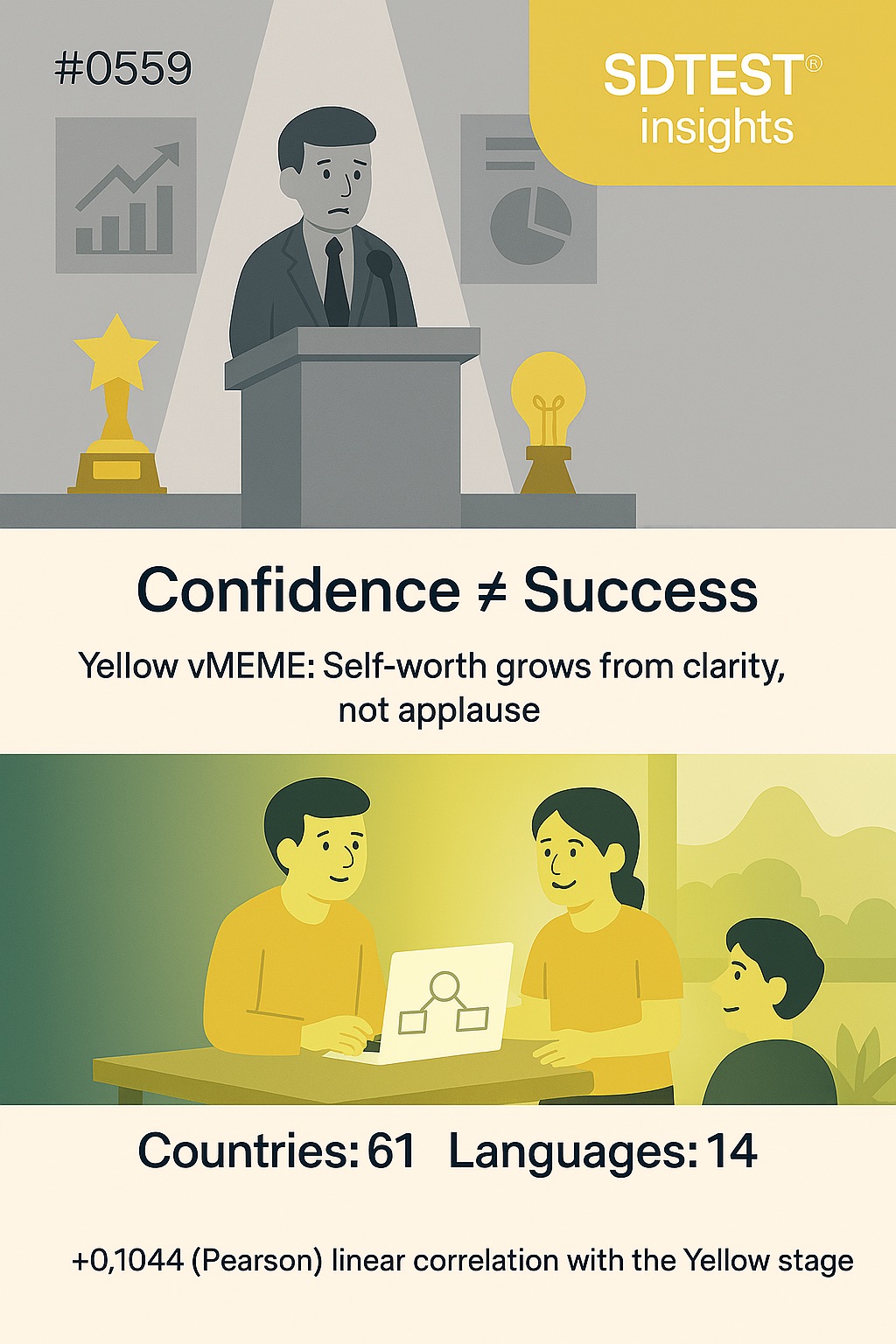
This negative correlation of -0.1044 between Success at Work and the Yellow stage offers profound insights when viewed through the lens of the Yellow value system:
Organizational Perspective:
Organizations operating within the Yellow mindset might interpret this correlation as:
- Validation of their integrative approach that recognizes self-confidence as emerging from multiple interconnected sources rather than singular professional achievements.
- Confirmation that their systems-thinking perspective understands conventional workplace success as just one limited dimension within the complex ecology of human development.
- Evidence supporting their belief that sustainable organizational effectiveness requires individuals who derive confidence from intrinsic growth rather than external validation markers.
These organizations might respond by:
- Implementing holistic development frameworks that integrate personal mastery, systems understanding, and multi-dimensional growth beyond traditional performance metrics.
- Creating environments that honor diverse pathways to confidence-building, recognizing that different individuals may find empowerment through various life domains.
- Promoting leaders who demonstrate integrated wisdom and can navigate complex organizational dynamics without depending solely on conventional success indicators.
Team Perspective:
Teams operating from a Yellow mindset might approach this correlation by:
- Viewing it as an affirmation of their multi-perspective approach, where team members' confidence emerges from diverse sources, including personal growth, systems understanding, and holistic development.
- Interpreting it as support for their belief that truly effective teams integrate individuals who have transcended narrow definitions of professional success.
- Seeing it as validation for prioritizing collective wisdom and adaptive capacity over traditional achievement-based team dynamics.
These teams might respond by:
- Establishing development processes that honor multiple intelligences and recognize confidence-building through various life experiences and learning modalities.
- Encouraging team members to explore diverse sources of self-worth, including creative expression, philosophical understanding, and personal transformation.
- Creating collaborative frameworks that leverage the integrated perspectives of individuals who have moved beyond conventional success paradigms.
Individual Perspective:
Individuals aligned with the Yellow value system might interpret this correlation as:
- Personal validation of their integrated approach to self-development that transcends a singular focus on professional achievement.
- Evidence supporting their understanding that authentic confidence emerges from systems awareness, personal mastery, and the ability to navigate complexity.
- Confirmation of their evolved perspective that sees workplace success as one element within a much larger tapestry of human development and self-actualization.
These individuals might respond by:
- Actively cultivating confidence through diverse pathways including philosophical inquiry, creative expression, systems understanding, and personal transformation.
- Viewing their independence from workplace validation as a sign of developmental maturity and integrated self-awareness.
- Using their multi-dimensional approach to confidence as a foundation for contributing unique perspectives and adaptive solutions in various contexts.
This correlation, viewed through the Yellow lens, suggests that those operating at the Yellow level may be less likely to rely on workplace success for building self-confidence. It implies that the Yellow value system's emphasis on integration, systems thinking, and transcendent perspectives aligns with a more holistic approach to self-worth and personal development.
The reasons why Success at Work might not be important for building self-confidence in the Yellow stage could include:
- Integrated Self-Awareness: Confidence emerges from understanding one's place within complex systems rather than from singular achievement domains.
- Multi-Dimensional Development: Self-worth is cultivated through diverse life experiences, learning modalities, and personal growth pathways.
- Transcendent Perspective: Recognition that conventional success metrics represent limited views of human potential and achievement.
- Systems Understanding: Awareness that workplace dynamics are influenced by multiple variables beyond individual performance, reducing attachment to external validation.
- Evolutionary Consciousness: Understanding that personal development involves transcending previous value systems' definitions of success and accomplishment.
This correlation prompts us to consider how different value systems influence the sources and foundations of self-confidence. It raises questions about the potential benefits and challenges of a Yellow approach to personal development, particularly in contexts where conventional achievement markers remain dominant cultural narratives.
Ultimately, this correlation highlights the complex interplay between consciousness development, self-worth, and professional identity. In Yellow-dominant consciousness, confidence might be viewed not as dependent on external validation but as an emergent property of integrated self-awareness, systems understanding, and the ability to navigate complexity with wisdom and adaptability.
In our analysis of the poll "Ageism in career," we found an intriguing positive linear correlation that warrants closer examination:
0.0973 (Pearson) between the Yes, the organization benefits from having a working group to keep the conversation on ageism, and the Turquoise stage.
The critical value of the correlation coefficient for a normal distribution, by William Sealy Gosset (Student), is r = 0.0757. Nevertheless, this positive linear correlation of 0.0973 meets the reliability criteria but does not necessarily imply causation.
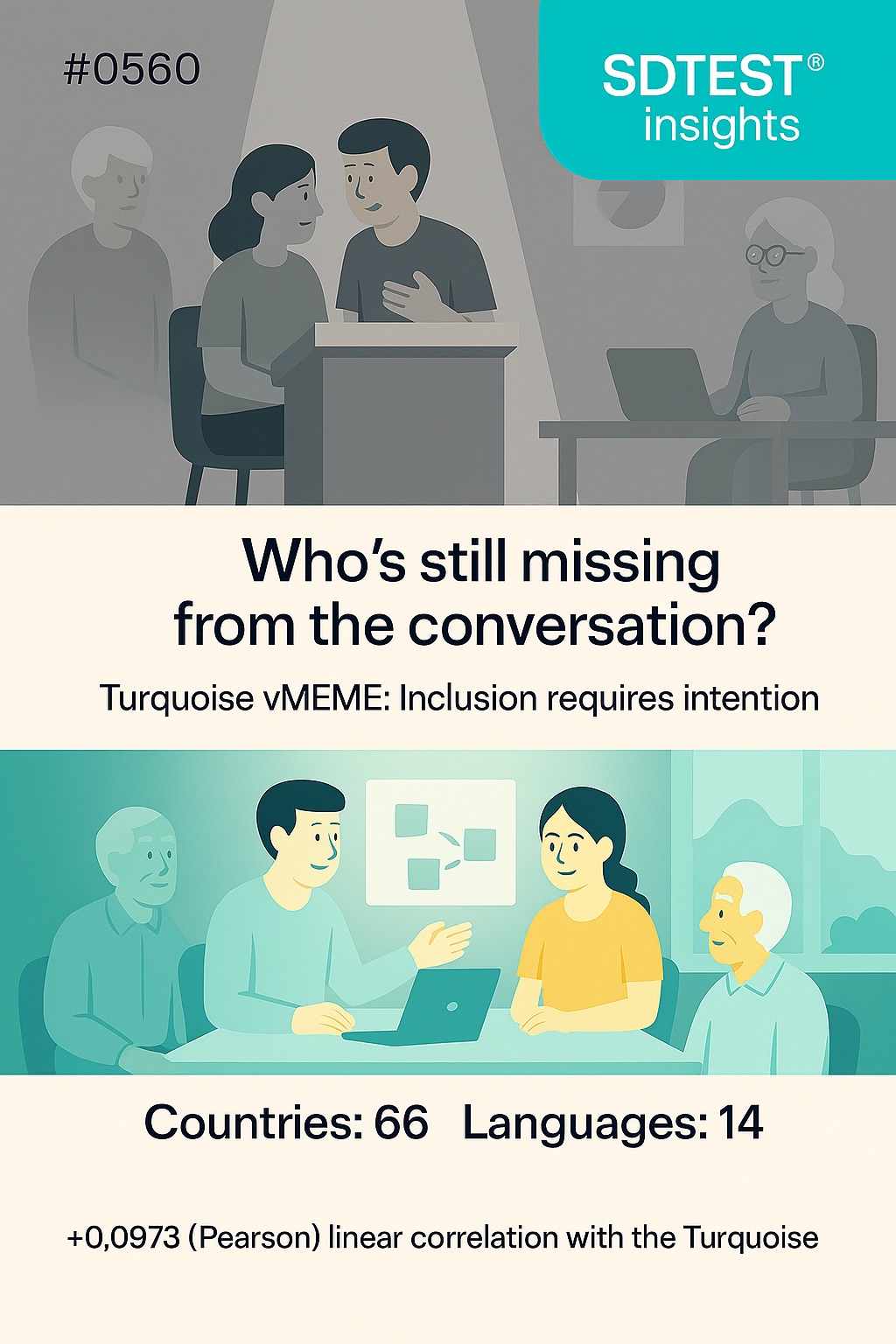
This positive correlation of 0.0973 between "Yes, the organization benefits from having a working group to keep the conversation on ageism" and the Turquoise stage offers profound insights when viewed through the lens of the Turquoise value system:
Organizational Perspective:
Organizations operating within the Turquoise mindset might interpret this correlation as:
- Validation of their holistic approach that recognizes ageism as one interconnected thread within the complex web of organizational diversity, equity, and systemic well-being.
- Confirmation that their ecological perspective understands age discrimination as disrupting the natural flow of wisdom, experience, and intergenerational collaboration essential for organizational sustainability.
- Evidence supporting their belief that continuous dialogue about ageism reflects their commitment to honoring all life stages and recognizing the interdependence of human development cycles.
These organizations might respond by:
- Implementing integrated working groups that address ageism as part of broader ecological systems thinking, connecting it to sustainability, diversity, and organizational harmony.
- Creating ongoing dialogues that honor the wisdom of all age groups while fostering intergenerational collaboration and mutual learning.
- Promoting leaders who demonstrate deep compassion for the full spectrum of human experience and can facilitate conversations that heal age-based divisions.
Team Perspective:
Teams operating from a Turquoise mindset might approach this correlation by:
- Viewing it as an affirmation of their integrative approach, where addressing ageism becomes a pathway to a deeper understanding of interconnected human experiences and collective wisdom.
- Interpreting it as support for their belief that ongoing conversations about age inclusivity strengthen the team's capacity for holistic collaboration and mutual respect.
- Seeing it as validation for prioritizing continuous dialogue that honors the natural cycles of human development and the valuable contributions of all life stages.
These teams might respond by:
- Establishing regular working groups that explore ageism as part of broader conversations about human dignity, interconnectedness, and collective flourishing.
- Encouraging team members to share their perspectives across generational lines, creating opportunities for mutual learning and wisdom exchange.
- Creating rituals and practices that celebrate the full spectrum of human experience while actively addressing age-based barriers to authentic collaboration.
Individual Perspective:
Individuals aligned with the Turquoise value system might interpret this correlation as:
- Personal validation of their holistic worldview that recognizes ageism as a symptom of disconnection from natural life cycles and human interdependence.
- Evidence supporting their understanding that sustained dialogue about age discrimination reflects deeper spiritual and ecological awareness of human dignity.
- Confirmation of their compassionate approach that sees addressing ageism as essential to creating harmonious, inclusive environments where all beings can thrive.
These individuals might respond by:
- Actively participating in working groups that address ageism while connecting it to broader themes of interconnectedness, sustainability, and universal compassion.
- Viewing their engagement with age-related conversations as an expression of their commitment to social and environmental justice.
- Using their systems awareness to help others understand how ageism disrupts the natural flow of wisdom and experience across generations.
This correlation, viewed through the Turquoise lens, suggests that those operating at the Turquoise level may be more likely to recognize the organizational benefits of sustained dialogue about ageism. It implies that the Turquoise value system's emphasis on holistic integration, ecological thinking, and universal compassion aligns with understanding ageism as a systemic issue requiring ongoing attention.
The reasons why organizations benefit from having working groups to address ageism in the Turquoise stage could include:
- Ecological Systems Awareness: Understanding that ageism disrupts the natural flow of wisdom, experience, and intergenerational collaboration essential for organizational health.
- Holistic Integration: Recognizing that age inclusivity connects to broader themes of diversity, sustainability, and universal human dignity.
- Interconnectedness Recognition: Seeing how age discrimination affects the entire organizational ecosystem and requires systemic healing approaches.
- Compassionate Engagement: Valuing ongoing dialogue as a pathway to deeper understanding and collective transformation around age-related biases.
- Evolutionary Consciousness: Understanding that addressing ageism represents part of humanity's evolution toward greater inclusivity and ecological harmony.
This correlation prompts us to consider how different value systems influence approaches to organizational justice and inclusion. It raises questions about the potential benefits and challenges of a Turquoise approach to addressing discrimination, particularly in contexts where systemic change requires both individual transformation and collective action.
Ultimately, this correlation highlights the complex interplay between consciousness development, social justice, and organizational evolution. In Turquoise-dominant environments, addressing ageism might be viewed not as a compliance issue but as a sacred opportunity to honor the full spectrum of human experience and create more harmonious, sustainable organizational ecosystems.
What insights do you gain from today's correlation? How might we study this relationship more carefully before deducing causation?
We welcome respectful and wise perspectives! Stay tuned every week as we share more results and insights.
After login or registration, free access to the poll results in the FAQ section.
[1] www.linkedin.com/in/mchalesiobhan/
2025.07.13
FearpersonqualitiesprojectorganizationalstructureRACIresponsibilitymatrixCritical ChainProject Managementfocus factorJiraempathyleadersbossGermanyChinaPolicyUkraineRussiawarvolatilityuncertaintycomplexityambiguityVUCArelocatejobproblemcountryreasongive upobjectivekeyresultmathematicalpsychologyMBTIHR metricsstandardDEIcorrelationriskscoringmodelGame TheoryPrisoner's Dilemma
Valerii Kosenko
Pwopriyetè pwodwi SaaS SDTEST®
Valerii te kalifye kòm yon pedagòg sosyal-sikològ an 1993 e depi li te aplike konesans li nan jesyon pwojè.
Valerii te jwenn yon diplòm Mèt ak kalifikasyon manadjè pwojè ak pwogram nan ane 2013. Pandan pwogram Mèt li a, li te vin abitye ak Pwojè Roadmap (GPM Deutsche Gesellschaft für Projektmanagement e. V.) ak Spiral Dynamics.
Valerii se otè a nan eksplore ensètitid la nan V.U.C.A. konsèp lè l sèvi avèk dinamik espiral ak estatistik matematik nan sikoloji, ak 38 biwo vòt entènasyonal yo.
